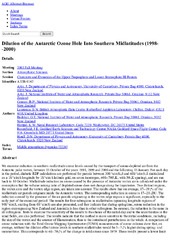Приказ основних података о документу
Dilution of the Antarctic Ozone Hole Into Southern Midlatitudes (1998-2000)
| dc.creator | Ajtić, Jelena | |
| dc.creator | Connor, Brian J. | |
| dc.creator | Lawrence, Bryan N. | |
| dc.creator | Bodeker, Gregory E. | |
| dc.creator | Hoppel, Karl W. | |
| dc.creator | Rosenfield, Joan E. | |
| dc.creator | Heuff, Darlene N. | |
| dc.date.accessioned | 2022-02-25T07:58:40Z | |
| dc.date.available | 2022-02-25T07:58:40Z | |
| dc.date.issued | 2003 | |
| dc.identifier.uri | https://vet-erinar.vet.bg.ac.rs/handle/123456789/2410 | |
| dc.description.abstract | We examine reduction in southern midlatitude ozone levels caused by the transport of ozone-depleted air from the Antarctic polar vortex, between 15 October of the years 1998, 1999 and 2000 and the following 15 January. For each day in the period, diabatic RDF calculations are performed for parcels between 30$^\circ$\,S and 60$^\circ$\,S (initialized on a 1$^\circ$ longitude by 1$^\circ$ latitude grid, on seven isentropes, 400--700\,K, with 50\,K spacing), and are run back to 10 October. Midlatitude reduction in ozone caused by the presence of Antarctic vortex air is calculated under the assumption that the volume mixing ratio of depleted ozone does not change along the trajectories. Two distinct regions, the vortex core and the vortex edge region, are taken into account. The results show that on average, 17--19\,% of the midlatitude air parcels originate inside the Antarctic vortex. The corresponding reduction in ozone is 17--21\,DU. The reduction caused by the presence of the air parcels originating in the vortex edge region is significant, especially in the early part of the examined period. The results for four subregions in midlatitudes (spanning longitude regions of 90$^\circ$, starting from 0$^\circ$) are also presented, and they indicate that during springtime, ozone reduction in the region encompassing New Zealand and Australia is less than in other subregions. In summer, the reduction is the same in all subregions. Tests to examine the sensitivity of the results to the choice of the initial day and to the uncertainties in the wind fields, are also performed. The results indicate that the method is more sensitive to the initial conditions, including the size of the vortex and the amount of filamentation, than to the introduced perturbations in the winds. A comparison of ozone reduction with the Total Ozone Mapping Spectrometer (TOMS) measurements of ozone column show that, on average, without the dilution effect ozone levels in southern midlatitudes would be 5--7\,% higher during spring- and summertime. This corresponds to 60--70\,% of the change in total ozone since 1979. These results present a lower limit of the impact, as dilution in the lowermost stratosphere and troposphere is not captured in the calculations presented here. | sr |
| dc.language.iso | en | sr |
| dc.publisher | AGU | sr |
| dc.rights | openAccess | sr |
| dc.source | Eos, Transactions, American Geophysical Union, 84(46), December 08–12, A32B-0142, San Francisco, USA | sr |
| dc.subject | Middle atmosphere dynamics | sr |
| dc.title | Dilution of the Antarctic Ozone Hole Into Southern Midlatitudes (1998-2000) | sr |
| dc.type | conferenceObject | sr |
| dc.rights.license | ARR | sr |
| dc.identifier.fulltext | http://veterinar.vet.bg.ac.rs/bitstream/id/6688/bitstream_6688.pdf | |
| dc.identifier.rcub | https://hdl.handle.net/21.15107/rcub_veterinar_2410 | |
| dc.type.version | publishedVersion | sr |

